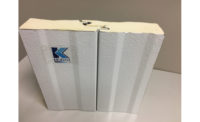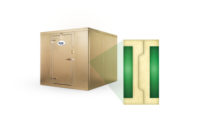By Wade Wheeler
The days when grocery shopping was solely an in-person, on-site event that involved the maneuvering of a shopping cart (wobbly wheel optional) through a maze of aisles have come to an end. Technological advances had already begun to make grocery shopping from home much more accessible and appealing in recent years. Then came March 2020.
The COVID-19 pandemic was a huge boost for the shop-from-home market segment in all industries. In the world of the supermarket, this phenomenon is called Online Grocery Pickup, or OGP. The main goal of OGP is to make sure that an online grocery order is filled for the customer in a timely and accurate manner, while not compromising food safety. Therefore, the physical pickup site must feature a climate-controlled cold-storage infrastructure that meets all the order accuracy, on-time delivery and food-safety demands of the customer.
The main challenge in developing an effective OGP cold-storage solution is that there is no one-size-fits-all answer for the unique physical infrastructure and footprint that each retrieval site possesses. Therefore, the companies that create climate-controlled cold-storage solutions for various OGP formats understand that managing and providing different cold-storage temperature levels is the foundation for a successful operation.
 Wade WheelerThe most basic OGP operation must have some form of cold storage to hold the groceries selected from the store for either customer pickup or delivery. More complex or larger OGP operations may need backroom storage coolers and freezers and assembly-line automation systems and even robotic automation that can optimize the order-filling process. Additionally, customers are not always able to retrieve their orders by driving up to the store or hopping inside to collect them.
Wade WheelerThe most basic OGP operation must have some form of cold storage to hold the groceries selected from the store for either customer pickup or delivery. More complex or larger OGP operations may need backroom storage coolers and freezers and assembly-line automation systems and even robotic automation that can optimize the order-filling process. Additionally, customers are not always able to retrieve their orders by driving up to the store or hopping inside to collect them. In most cases, the OGP operation will need walk-in coolers and/or freezers to keep the purchased products at their proper temperature before they are picked up. The ideal cooler/freezer setup should include insulated panel systems that have been designed specifically for use in creating climate-controlled cold-storage systems. Also, highly effective in these situations is a modular-design approach that makes the storage units highly adaptable and easy to install, whether a single- or multi-compartment unit is required. Each system also must be able to be custom designed and engineered to meet the unique specifications of the end user’s project.
A high-performance walk-in cooler/freezer unit is typically constructed of insulating panels with an exterior metal skin that is sandwiched around poured-in-place closed-cell polyurethane foam. This method of design and construction creates three main benefits for the user:
- The insulated panels are highly energy efficient and have R-values (the ability to resist invasive energy flow) that are not only relevant to the specific project, but meet or exceed industry standards.
- Closed-cell polyurethane foam has the highest R-value of any insulation used in the refrigeration industry and is able to produce an R-value of up to 8.06 per inch of thickness.
- The insulated panels are outfitted with a cam-lock system that enables them to be securely joined together via a cam-and-pin housing assembly that both forms a sturdy, vapor-tight connection between individual panels while maintaining the system’s R-value.
Through a customized approach, providers of insulated-panel solutions are able to create individual solutions for each store that meet specific customer needs for walk-in coolers and freezers, along with many non-traditional applications. When creating a customized insulated-panel system, there are four key differentiators that must be addressed:
- Design and Engineering Process: You cannot design the best insulated-panel system without assistance from detail-oriented expert design and engineering teams. There are often complex requirements, such as size and capacity, which must be taken into consideration before manufacturing. Little mistakes when selecting and sizing the insulated-panel system can have a huge impact on its efficiency, durability and reliability.
- Manufacturing and Shipping Process: Once designed, the manufacturing process itself is critical to the level of quality of the completed insulated-panel system. All panels are not created equal, so the manufacturing process must combine factory-trained experts with high-tech equipment that has been designed to optimize the process. Each panel should be individually manufactured and put into different assembly lines based on complexity. To track each product, a detailed panel label should be put on each panel to ensure that the exact specifications are met during manufacturing. Additionally, once they are manufactured, the panels must be specifically packaged with delivery and installation in mind. In this instance, the panels should be grouped according to the way in which they will be installed and then packaged using an orbital wrapper so they are shrink-wrapped for delivery. The shrink wrapping provides next-level protection that will help limit any potential damage during transportation.
- Vendor Capabilities: Creating the best insulated-panel systems involves a variety of different components from display doors to refrigeration units, alarms/controls, cold-storage doors, shelves and lighting. Each component is available in many different types and styles, and from a variety of vendors. The best approach in this situation is to be vendor agnostic. By working with a variety of high-quality vendors rather than limiting options, the best customized solution can be built. Every vendor should be regularly evaluated for quality, on-time delivery performance and cost-competitiveness to help ensure that the customers is working with only top vendors.
- Installation: Installation can make or break the entire performance of an insulated-panel system. Incorrectly installed panels can cause outside air to come in, which can drastically affect temperature. As a result, the system may not be able to maintain the correct temperature, causing the formation of condensation and other issues. At the installation site, each panel label should have a specific number and identifier in order to ease the installation process. Additionally, some panel providers will offer their own installation services. A competent and reliable installation department should include in-house trained experts who are specifically taught how to install the panels according to factory specifications. Direct-installation services can be the final piece that helps ensure the best insulated-panel system from spec to install.
After addressing these differentiators and making the best choice for your operation, tying it all together is after-sales support. Working with a company that not only handles the design and engineering, manufacturing, shipping, and installation also needs to have a robust after-sales support structure in place.
Finally, when it comes to the backroom operations, it is important to not compromise on the insulated-panel system. A correctly designed, manufactured and installed cold-storage solution is the backbone of the backroom. When choosing a manufacturer, make sure to look for the key considerations described above. One of the biggest mistakes that can be made is choosing an installer based on the cheapest option. Price and quality are highly related in terms of cold-storage solutions, and the price you might pay in the long run for an inefficient insulated-panel system will be much more than a higher cost upfront.
Conclusion
The panels used in cold-storage unit must be highly reliable, efficient, safe and cost-effective and able to be designed, engineered and built to the customer’s customized dimensions. Operators are finding great success when their cold-storage units are constructed with double-wall insulated panels that are filled with closed-cell polyurethane foam. This gives the unit best-in-class energy efficiency and R-values, which makes optimization of the specific application easier to achieve.
Wade Wheeler is a Customer Experience Manager for KPS Global, Inc., based in Fort Worth, Texas.



